Aesthetic Lamps: Elevating Your Bedroom Design
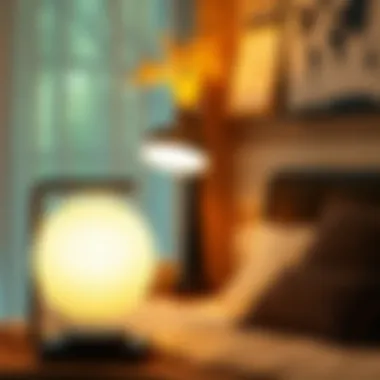
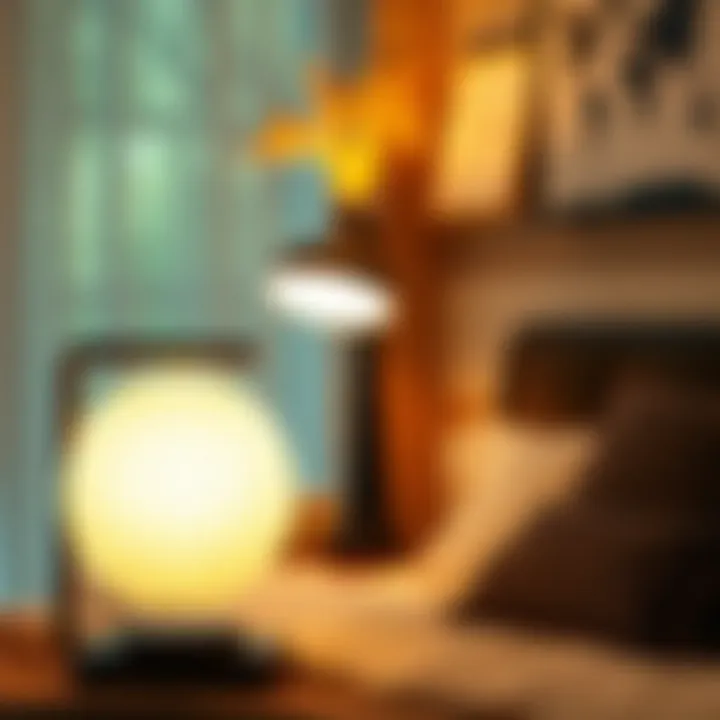
Intro
Lighting can completely transform a space, and in bedroom design, aesthetic lamps hold a particular significance. They are not mere sources of illumination but vital components that shape the ambiance and mood of the room. This article explores the various styles, materials, and functionalities of aesthetic lamps, guiding readers in choosing the right ones for their personal aesthetics and functional needs. The focus lies not only on the physical attributes of lamps but also on how they can create an atmosphere tailored to our feelings and experiences.
By looking at furniture arrangements, color palettes, and themes, we’ll see how these lamps play a crucial role in bedroom design. With careful consideration, you can select lighting fixtures that enhance the character of your room. Whether you prefer a minimalist feel or a cozy, bohemian vibe, aesthetic lamps can be the perfect finishing touch.
Additionally, we will dive deep into practical aspects such as placement, energy efficiency, and the current trends in lighting design. This comprehensive guide ultimately aims to present illuminating insights that help you curate the perfect lighting scheme for your personal sanctuary.
Understanding Aesthetic Lamps
In the realm of interior design, lighting plays a pivotal role in shaping the overall atmosphere and functionality of a space. When it comes to bedrooms, aesthetic lamps are more than just sources of illumination; they are integral components that can enhance style while serving practical needs. Grasping the essence of aesthetic lamps involves recognizing their multifaceted nature and the significant role they play in bedroom design.
Definition of Aesthetic Lamps
Aesthetic lamps can be defined as lighting fixtures that emphasize both form and function, pleasing the eye while catering to practical lighting needs. These lamps come in various designs, materials, and styles, reflecting individual tastes and complementing the overall decor of the room. They might range from sleek, modern designs made of metal and glass to more whimsical options, like vintage-inspired fixtures adorned with intricate detailing. At their core, aesthetic lamps serve to bridge the gap between functionality and aesthetic appeal, making them essential in any thoughtfully designed bedroom.
Importance of Lighting in Bedroom Design
The importance of lighting cannot be understated when it comes to creating a cozy, relaxing, or vibrant bedroom environment. Here are a few points underscoring the necessity of effective bedroom lighting:
- Mood Setting: The right lamp can set an inviting ambiance, whether it's for winding down with a book or energizing oneself for a new day. Dim lighting can foster relaxation, while brighter settings are ideal for activities that require focus.
- Style Amplification: A lamp that harmonizes with the rest of the decor can elevate the room's aesthetic appeal. Think of how a mid-century modern lamp can perfectly complete a room filled with similar influences.
- Functional Aspects: Beyond the aesthetics, lamps also serve practical roles—reading, illuminating dark corners, or brightening workspaces. A poorly lit room can affect both functionality and mood.
- Highlighting Design Elements: A well-placed lamp can draw attention to art pieces, furniture, or architectural features, adding depth and character to the room.
"Aesthetic lamps are the unassuming heroes of interior design. Their ability to blend functionality with style transforms any bedroom into a sanctuary of comfort and personal expression."
Types of Aesthetic Lamps
When it comes to transforming a bedroom into a serene haven, aesthetic lamps play a pivotal role. Not only do they illuminate a space, but they also contribute to the overall ambiance, texture, and style. Each type of lamp serves its unique purpose, making it essential to choose wisely to complement the specific decor and functional needs of the room. With various designs available, let's break down the distinct categories of aesthetic lamps and their benefits.
Table Lamps
Table lamps are like the cherry on top when it comes to bedroom decor. Often found on nightstands or desks, these lamps provide localized lighting that is ideal for reading or working in bed. Their footed bases often bring a touch of elegance or novelty, depending on the design—think of a sleek metal frame contrasted with a colorful lampshade.
"A well-chosen table lamp can serve as a statement piece, enhancing the room's style significantly."
These lamps come in myriad styles—contemporary, vintage, or even handmade crafts. Don't overlook the flexibility they offer; they can easily be moved around to match your mood or activity. Consider pairing a brightly colored shade with neutral furniture, or a dark and moody lamp with lighter decor for dramatic effect.
Floor Lamps
Floor lamps stand tall and proud, often acting as focal points in a bedroom. They can bring height to a space that feels flat or create a cozy nook with a warm glow. Their versatility allows them to be placed in corners, beside chairs, or behind sofas, making them an element of design rather than just a source of light.
When choosing a floor lamp, think about the kind of light it casts. Some feature adjustable arms or shades for directionality, and others emit a more diffused glow, suitable for relaxation or evening meditation.
Opt for a slim profile if space is tight; a sleek and minimalist design can accommodate tight corners without overwhelming the room.
Wall Lamps
Wall lamps, or sconces, often provide a stylish way to save space while adding elegance. They are useful in smaller bedrooms where floor or table space is limited. Mounted fixtures can illuminate walls or artwork, creating an inviting atmosphere.
One advantage of wall lamps is their ability to serve both functional and decorative purposes. Swing-arm models, for example, work fabulously beside beds for reading without taking up precious nightstand real estate. In terms of ambiance, placement can dramatically influence how warm or inviting a space feels.
Pendant Lamps
Pendant lamps hang from the ceiling and can swing from stylish to whimsical. They bring character and a unique design element to the bedroom. Positioning a pendant lamp over a bedside table or in the center of a room can serve as both lighting and a conversation starter.
The variety in shapes, sizes, and materials is staggering—from modern glass globes to rustic industrial designs. This allows homeowners to match them seamlessly with their existing aesthetic. Think of a striking pendant lamp as the jewelry of the room, adding that much-needed sparkle and sophistication.
By evaluating the types of aesthetic lamps available—table, floor, wall, and pendant designs—one can strategically enhance the bedroom's lighting and style. Each type has its own benefits and can elevate the overall mood and design scheme of the personal space.
Materials and Aesthetics
When it comes to aesthetic lamps, the choice of materials plays a critical role in not just the lamp's functional aspect but also its overall visual appeal. Each material brings its own unique flavor, adding character to bedroom decor and contributing to the ambiance. Beyond just light sources, these lamps often become statements of style, reflecting the owners' tastes and preferences. Therefore, understanding materials and aesthetics helps in making informed decisions that harmonize with bedroom designs.
Metal Fixtures
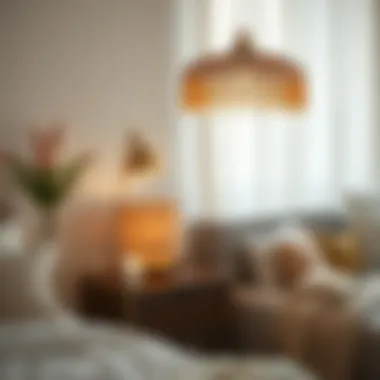
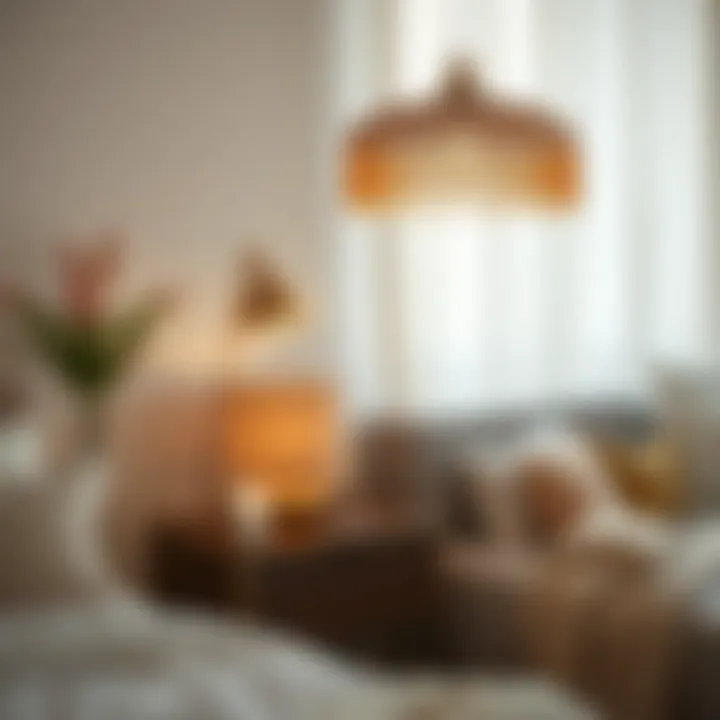
Metal fixtures are a popular choice in aesthetic lamps for several reasons. Firstly, they tend to be durable and resistant to wear and tear, making them a practical option for long-term use. Depending on the finish—whether polished chrome, antique bronze, or matte black—metal can evoke a range of styles from modern minimalist to rustic vintage.
Another attractive feature of metal fixtures is their versatility. They can seamlessly fit into diverse decor themes. For instance, a brass lamp can complement an industrial or eclectic room, while a sleek stainless-steel base might suit a contemporary space more. Additionally, metals can be paired creatively with other materials, such as wood or glass, to enhance the lamp's aesthetic and functionality.
Glass Shades
Glass shades are an intriguing aspect of aesthetic lamps. They offer elegance and charm, often acting as a centerpiece in a room. The translucence of glass allows light to diffuse softly, creating a warm ambiance that enhances the nighttime allure of a bedroom.
Different types of glass can significantly change the feel of lighting. Frosted glass provides a soft glow, while clear glass can give a more direct light, ideal for tasks like reading. Styles also vary: colored glass can introduce playful hues, while textured or etched designs bring in tactile sensations. The combination of glass with either metal or wood bases amplifies the aesthetic appeal, striking a balance between modern sophistication and traditional warmth.
Wooden Elements
Wooden elements in lamps speak to a naturalistic approach, allowing for a connection to nature even in the confines of a bedroom. They are particularly effective in spaces aiming for a cozy or rustic theme. The warmth of wood brings a tactile quality, making bedrooms feel more inviting.
Different types of wood, such as oak or walnut, provide distinctive hues and grains. Reclaimed wood adds a layer of history and sustainability, appealing to eco-conscious homeowners. Additionally, wooden lamps can come with intricate carvings or minimalist designs, offering flexibility in style. They can blend seamlessly with other decor or stand out as a unique focal point, enriching the room's overall storytelling.
Fabric Lampshades
Fabric lampshades are a fantastic avenue for introducing texture and color into your bedroom decor. Unlike rigid materials, fabrics like linen or silk can produce softer light, creating a comforting atmosphere that's perfect for relaxation. The patterns, colors, and textures available are practically limitless, allowing homeowners to get creative.
For example, a vibrant geometric pattern might energize a modern room, while soft floral designs can soften a more traditional space. Additionally, fabric shades can be easily changed or updated, making them a dynamic choice for those who like to refresh their interiors regularly. They are also typically lightweight, which can ease the process of lamp placement and style evolution in any bedroom setting.
In summary, choosing the right material not only confirms the functionality of aesthetic lamps but largely enhances the overall design narrative of your bedroom. Whether opting for metal, glass, wood, or fabric, each element contributes uniquely to the welcoming atmosphere that enhances the bedroom experience.
Functionality and Features
When it comes to aesthetic lamps in the bedroom, functionality and features can’t be an afterthought. These elements play a crucial role in shaping how well a lamp serves the space, meeting both practical needs and enhancing the overall ambiance. Selecting the right features not only caters to personal preferences but also considers lifestyle demands. Let’s delve into a few key functionalities commonly found in modern aesthetic lamps.
Adjustable Brightness
Having control over light intensity in a bedroom is like having a fine-tuned instrument for mood setting. Adjustable brightness allows users to adjust the light to match different times of the day or specific activities. A dim, warm glow can be inviting for unwinding before bed, while brighter light can help energize you during morning hours.
- Versatile Use: Whether you’re reading, working, or simply relaxing, the ability to customize brightness transforms the lamp's utility.
- Layering Light: With adjustable illumination, multiple lamps can blend together seamlessly, creating a dynamic light environment. For instance, a soft table lamp paired with a brighter overhead fixture might cater to various activities throughout the day.
"Light is not just illumination; it's an atmosphere, it's a feeling."
Smart Lamps
The surge of technology in home decor has given rise to smart lamps. These lamps go beyond mere aesthetics, integrating with smart home systems to offer enhanced convenience and customization options. Imagine controlling your lamp with a few simple taps on your phone or even through voice commands!
Some important features of smart lamps include:
- Remote Control: Manage lighting without leaving your cozy spot—ideal for late-night Netflix binges.
- Timers and Schedules: Set lamps to automatically turn on or off, helping reinforce healthy sleep routines or create a welcoming ambiance when you arrive home.
- Color Change: Many smart lamps allow you to change colors, thus providing versatility for moods and celebrations alike.
Energy Efficiency
In today’s eco-conscious world, the energy efficiency of lamps has gained significant traction. Not only do energy-efficient lamps reduce electricity bills, but they also contribute positively to the environment.
- LED Technology: LED lamps are a popular choice for their longevity and low energy consumption compared to traditional incandescent bulbs, making them a smart investment.
- Sustainability: Some lamps are designed with recycled materials or packaging, aligning with a greener lifestyle.
- Lower Heat Emission: Unlike traditional bulbs that emit significant heat, energy-efficient lamps keep your room cooler, benefiting both comfort and reducing air conditioning costs.
When choosing aesthetic lamps, evaluating functionality and features should be as vital as aesthetic appeal. With options like adjustable brightness, smart technology, and energy efficiency, homeowners can find the perfect balance between beauty and practicality.
Choosing the Right Aesthetic Lamp
Choosing the right aesthetic lamp for your bedroom might seem a trifle at first glance, but it can remarkably influence not just the decor but the entire vibe of your personal space. An aesthetically appealing lamp doesn’t merely light the room—it shapes moods, elicits emotions, and even reflects one’s personal style. Getting this choice right may require a wee bit of introspection and understanding of the elements that matter most to you.
When diving into the selection process, it is crucial to consider your lifestyle, preferences, and the overall atmosphere you wish to create. From functionality to style, scrutinizing these aspects carefully will help in steering your choice toward the right lamp. Don't aim for a piece that merely fills space; instead, look for something that speaks to you and complements the ambiance you wish to nurture.
Assessing Personal Style
Personal style is a complex tapestry woven from various influences—be it art, fashion, or childhood experiences. To assess your own style, start with what resonates with you emotionally. Consider a few prompts:
- Color Palette: What colors do you gravitate toward? Soft pastels, vibrant pops, or moody, dark shades?
- Materials: Do you prefer earthy wood, chic metal, or perhaps the elegance of glass?
- Shape and Design: Are you drawn to clean lines and minimalism, or do your tastes veer towards busy, eclectic shapes?
Once you have a clearer picture, you can explore options that align with these facets. Remember, personal style is not static. It evolves, and your lamp choice could reflect this journey—embracing change while staying true to your core essence.
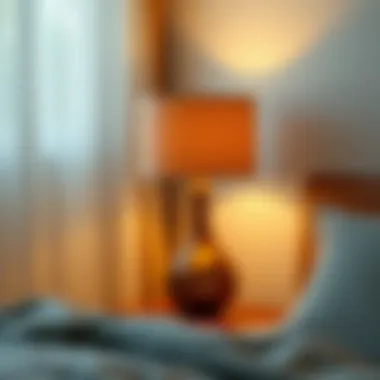
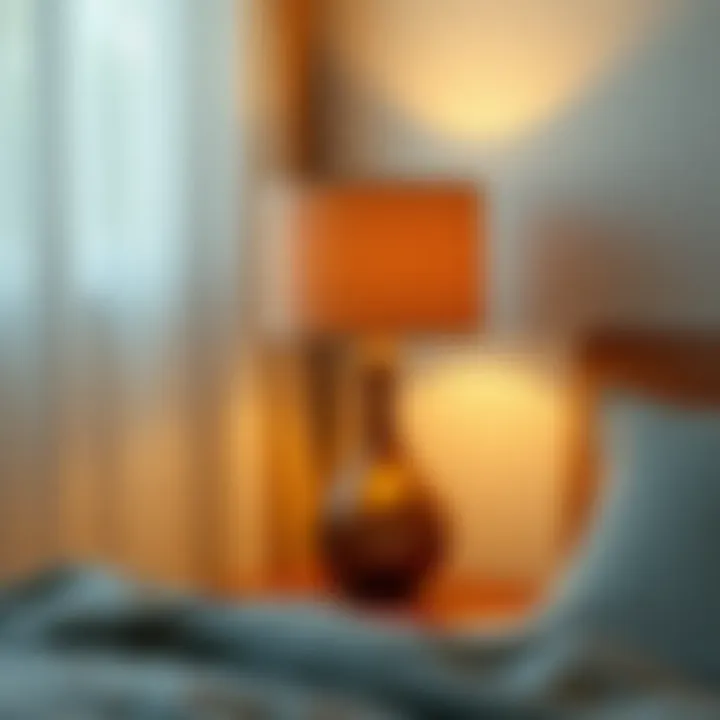
Matching Lamp to Bedroom Theme
Lighting, albeit often overlooked, can accentuate the theme of your bedroom like few other decorative elements. If your realm is a serene sanctuary leaning towards Scandinavian minimalism, a sleek metal floor lamp might sit with elegance at the corner without overwhelming the room. Conversely, if your space boasts a bohemian flair adorned with rich textiles and artifacts from your travels, selecting a lamp that embodies unique, organic shapes or intricate patterns would harmonize beautifully with your decor.
To help in this matching process, ponder upon these questions:
- Existing Decor Style: What style dominates your room? Is it traditional, modern, or a blend?
- Color Coordination: Does the lamp’s color scheme meld with the other colors present in your bedroom?
- Proportion and Scale: Is the size of the lamp appropriate for the available space, neither dwarfing other elements nor seeming too imposing?
As you navigate through these considerations, you might spot a trend that resonates with current designs. For instance, many bedroom themes now integrate biophilic designs, so natural materials might be the flavor of the month. But at the end of the day, ensure your lamp isn’t just a passing trend; it should truly speak to you.
The right lamp can turn a mundane corner into a focal point, merging light with art in perfect unison, creating a space that is distinctly yours.
Integrating your aesthetic choice into your selection not only elevates the visual appeal but also ensures that your unique style echoes throughout your sanctuary. In the end, choosing the right aesthetic lamp is more than mere functionality; it's about crafting an atmosphere reflective of your individuality.
Placement Considerations
When it comes to designing a bedroom, placement of aesthetic lamps can make or break the overall vibe of the space. Not only does the right lamp create a specific mood, but the way you position it can also optimize the functionality of your lighting. Every nook and cranny holds potential for creating a luminous retreat, but achieving that requires thoughtful consideration of where to place each lamp.
Optimal Lighting Locations
Finding the optimal locations for your aesthetic lamps isn't just about spotting an empty surface. It's about creating a harmonious flow of light that complements the room's architecture and furnishings. Here are some key points to consider:
- Near Functional Areas: Positioning lamps close to beds or reading nooks enhances usability. A lamp on the bedside table ensures you have light for nighttime reading without having to get out of bed.
- Corner Accentuation: Brightening up dark corners creates a stylish contrast and helps the room feel larger. A tall floor lamp with a soft glow can warm up an empty corner while adding texture to your decor.
- Overhead Lighting Balance: If your bedroom has overhead fixtures, make sure to balance them with your lamps. Sometimes, a well-placed table lamp can soften harsh overhead light and promote a cozy atmosphere.
- Artwork Spotlighting: If you have cherished wall art or a family photo gallery in your bedroom, placing a lamp nearby can draw attention to these elements, making them focal points that add personality to the room.
By carefully selecting lamp positions, you align function with aesthetics, transforming your space into a sanctuary of style and comfort.
Balancing Light Sources
Achieving a comfortable lighting balance in your bedroom involves blending various light sources, including your aesthetic lamps. This approach promotes a well-rounded ambiance that caters to different activities and moods. Here’s how to do it effectively:
- Layer Your Lighting: Use a mix of ambient (overhead), task (reading), and accent (decorative) lighting to create depth. Task lamps can shine brightly where you need focused light, and softer decorative lamps can maintain a relaxed vibe.
- Adjust for Versatility: Choose lamps with adjustable features, like dimming capabilities or multiple brightness levels. This allows you to fine-tune the intensity according to the time of day or activity.
- Create Symmetry: If your room layout permits, consider placing lamps symmetrically. For example, matching table lamps on either side of the bed can enhance the sense of balance and sophistication.
In balancing light sources, you’re not only looking to illuminate the space but also to convey an emotional response. A well-lit room is welcoming and refreshing, making it feel like a true retreat.
"Lighting is not just about visibility; it's about creating an experience. The way light interacts with a space can transform it entirely."
Through smart placement and careful balancing, the aesthetic lamps in your bedroom will do more than just provide light; they will enrich the atmosphere, creating a backdrop for comfort and elegance.
Trends in Aesthetic Bedroom Lighting
Staying attuned to the current trends in aesthetic bedroom lighting is more than just a passing fancy; it’s essential for creating a space that is both functional and reflective of one’s personal style. In bedrooms, lighting does not merely serve a utilitarian purpose; it shapes the atmosphere, accentuates decor, and can even evoke various emotions. Exploring current trends allows decorators and homeowners to integrate fresh ideas into their spaces—besides, who doesn’t appreciate a cozy, inviting bedroom?
Minimalist Approach
The minimalist approach has surged in popularity over the past few years, driven by the desire for simplicity and functionality. This style thrives on clean lines, neutral colors, and uncluttered aesthetics. In the realm of lamps, this often translates to designs that strip away unnecessary embellishments, focusing instead on form and function. A simple pendant lamp with a geometric shade or a sleek floor lamp can fit in seamlessly, ensuring that the light remains soft and unobtrusive, allowing other design elements to shine.
Incorporating minimalist lamps often involves the careful consideration of placement. Here are some key pointers:
- Select neutral tones to maintain a cohesive look across the bedroom.
- Favor versatile designs that can blend in with various styles, allowing for easy updates.
- Ensure functionality remains paramount; a lamp that looks good but doesn’t serve its purpose efficiently can defeat its own appeal.
Vintage Styles
On the flip side, vintage styles continue to charm homeowners, adding a dash of nostalgia to modern interiors. Vintage lamps—like antique brass table lamps or retro glass sconces—bring warmth and character into the bedroom. The beautiful patina of aged metals or the rich textures of handblown glass evoke a sense of history, making them conversation starters.
When exploring vintage options, consider these elements:
- Repurposed materials: Eco-conscious buyers often look for lamps made from reclaimed wood or upcycled materials. This not only aids sustainability but also adds a unique touch.
- Character-filled designs: Lamps featuring intricate details or artistic craftsmanship can serve as focal points in a room.
- Mixing eras: Combining vintage lighting with contemporary decor can create a delightful contrast, emphasizing each piece's unique qualities. This could be as simple as pairing a retro lamp with modern furniture.
Biophilic Design Elements
The trend toward biophilic design—which seeks to connect occupants more closely to nature—has made its way into bedroom lighting, emphasizing the role of organic shapes and natural materials. Aesthetic lamps following this trend often feature designs inspired by natural forms, such as leaf motifs or earthy textures. They can evoke a sense of calm, perfect for spaces meant for rest.
Elements to look for when considering biophilic designs include:
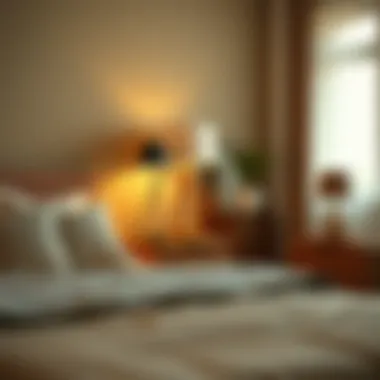
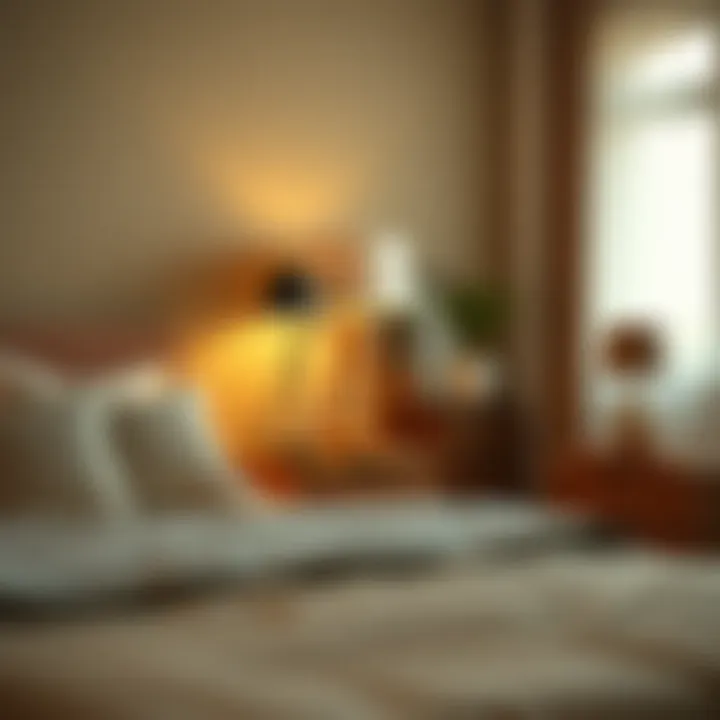
- Natural materials: Look for lamps made from wood, stone, or even bamboo. These materials not only add warmth but also bring a touch of nature indoors.
- Soft, diffused lighting: Lamps that provide a gentle glow mimic the natural lighting found outdoors, enhancing relaxation.
- Greenery integration: Some innovative designs even incorporate planters or space for small plants, creating a harmonious blend of lighting and nature.
"Lighting can transform a space. Remember, it’s not just about lumens, but the mood it creates in your sanctuary."
With an eye on these trending elements in aesthetic bedroom lighting, homeowners and interior design enthusiasts can make informed choices that reflect their personal style while enhancing the overall ambiance of their bedrooms. Whether you lean toward a minimalist vibe, a touch of vintage, or a refreshing perspective with biophilic elements, the right lamps can remarkably heighten the experience of the sanctuary we call home.
Combining Aesthetic Lamps with Other Decor
In the realm of interior design, lighting often plays a pivotal role in not just functionality but also in the creation of ambiance and style. When it comes to bedrooms, aesthetic lamps serve as vital elements that harmonize with other decor items. Combining aesthetic lamps with various decor can drastically alter a bedroom's atmosphere, making a space feel more inviting and personal.
Layered Lighting Techniques
The phrase "light layering" encapsulates the concept of using multiple light sources within a single space to create depth and visual interest. The primary essence of layered lighting lies in balancing three types of lighting: ambient, task, and accent. Ambient lighting lays the foundation, offering overall illumination, while task lighting focuses on specific areas—like reading nooks or vanities—illuminating them without overshadowing the rest. Accent lighting, on the other hand, draws attention to particular features or artwork in the bedroom.
When combining aesthetic lamps, consider their placement deliberately. For instance, a stylish table lamp on a nightstand could coexist beautifully with a sleek floor lamp in the corner. This synergy not only ensures adequate lighting but also enriches the bedroom’s overall aesthetic. To deepen this effect, utilizing dimmable lamps allows for a smooth transition from light to shadow, enhancing the cozy aspect of the space during the evening.
Here are some practical ways to incorporate layered lighting in a bedroom:
- Use multiple lamps: Place a table lamp next to the bed and a floor lamp near a reading chair.
- Mix light temperatures: Combine warm white lights with cooler tones to create contrast.
- Experiment with height: Vertical variation can add intrigue; tall floor lamps versus lower bedside lamps bring visual interest.
Complementary Decor Styles
The beauty of aesthetic lamps lies in their versatility. They have the potential to complement a myriad of decor styles, from minimalist to bohemian, or even industrial looks. Choosing the right lamp isn’t just about functionality; it’s also about enhancing the existing design elements within the bedroom.
When selecting lamps, think about the materials and colors in the room. For instance, a vintage brass lamp might flow seamlessly with mid-century furnishings, whereas a sleek, modern lamp can uplift a contemporary decor theme. Keeping the color palette in harmonized tones further enriches the visual appeal, allowing the lamp to become an integral part of the overall decor.
Here are some pointers to consider when matching aesthetic lamps with decor:
- Reflect existing materials: If your bedding features a lot of wood, a wooden-base lamp can create continuity.
- Identify your style: Use lamps to define or enhance your bedroom’s theme—a minimalist space may benefit from a geometric-shaped lamp, while a cozy room might call for a fabric shade.
- Coordinate colors: Complementary colors can create a cohesive feel; color theory can be a helpful guide in choosing the right lamp.
"The right lighting can transform an ordinary room into a spectacular sanctuary."
By blending and balancing lamps with other decor pieces, homeowners can cultivate a unique atmosphere that reflects their personal style, ensuring that the bedroom isn’t just a place to sleep but a haven that resonates with individuality.
Maintaining and Caring for Lamps
Keeping your aesthetic lamps in tip-top shape is not merely a matter of aesthetics; it’s also about prolonging their life and ensuring they operate efficiently. Failing to pay attention to upkeep can lead to diminished performance, which can affect the ambiance of your cherished personal space. Proper maintenance can also enhance safety, preventing electrical hazards that might arise from dust accumulation or faulty wiring.
Cleaning Tips
A good cleaning goes a long way in maintaining the beauty and functionality of your lamps. Here are some insightful cleaning tips to follow:
- Dust Regularly: Dust can collect on lampshades and bases, dulling their sparkle and potentially obstructing light. Use a microfiber cloth to wipe down surfaces often.
- Choose the Right Cleaner: For metal lamps, a gentle polish can restore shine. In contrast, glass shades require a different approach. Opt for a vinegar-water solution for that sparkling finish.
- Remove Shades: If the lampshade is detachable, take it off and clean it separately. Fabric shades might benefit from a light vacuuming or a fabric-safe cleaner to wash off stains.
- Inspect Bulbs: While cleaning, check the bulbs for any signs of wear. A flickering bulb is not just annoying; it could also be a safety concern.
Regular Upkeep
Routine maintenance goes hand in hand with cleaning. It helps ensure your lamps remain safe and function correctly:
- Check Wiring and Connections: Take a moment to look over any visible wiring. A simple visual inspection might reveal frayed cords or loose connections, which can be dangerous. If anything looks amiss, consult a professional.
- Change Bulbs Periodically: Regularly replacing bulbs keeps lighting consistent and ensures the aesthetic quality of your setup. Using LED bulbs can be particularly beneficial, as they tend to last much longer.
- Test Switches: Flicking the switch should be smooth. If there's a hitch, it could signal an internal issue that needs attention.
- Store Properly: When not in use, especially seasonal lamps or those you rotate, keep them in a dry area. Proper storage can prevent dust from settling and damaging surfaces.
By integrating these tips and upkeep practices into your routine, you’re not just maintaining your lamps; you’re nurturing an environment that reflects your style while ensuring safety and functionality. This harmony between aesthetics and maintenance enables you to enjoy your space without worry.
Closure: The Role of Aesthetic Lamps in Bedroom Design
Aesthetic lamps are not just a source of light; they are a critical component of bedroom design. These fixtures stand as powerful statements that can drastically alter the atmosphere of a space. As we've discussed throughout this article, the role of lighting goes far beyond mere functionality. When thoughtfully incorporated, lamps can enhance various elements, contributing to ambiance, style, and overall comfort of the room.
Synthesis of Aesthetic and Functionality
In the dance of aesthetics and utility, finding the perfect balance is key. A well-designed aesthetic lamp can uplift the decor while serving practical needs. Functionality is often about ensuring the right type and level of light. For instance, a bedside table lamp needs to provide sufficient illumination for reading but also contribute to a cozy ambiance. Choosing the right bulb and shade type can influence everything from brightness to color temperature, affecting how the space feels. Additionally, features like adjustable brightness allow flexibility in mood setting.
Emphasizing a lamps’ aesthetic appeal complements its functional merit. A vintage or artisanal lamp can evoke a sense of nostalgia and warmth, whereas sleek, modern designs often add an air of sophistication. It’s this interplay that draws people to specific styles and shapes, making personal taste crucial in the decision-making process. Ultimately, the best aesthetic lamps seamlessly blend beauty and purpose, ensuring that one does not compromise the other.
Final Thoughts on Bedroom Lighting
As we wrap up this exploration, it's imperative to recognize that lighting can transform more than just the appearance of a room; it shifts our emotional state as well. When you step into a bedroom filled with soft, warm light from well-chosen lamps, it feels like a sanctuary. In contrast, harsh or poorly placed lighting can leave one feeling unsettled. Therefore, investing time in understanding your needs and the types of lamps available is vital.
Reflect on how you want your space to function at different times – whether it’s for cozy evenings, reading nights, or vibrant mornings. Merging your personal style with the characteristics of aesthetic lamps can lead to spaces that are not just visually appealing but also reflect your lifestyle.
"Lighting is not just about visibility; it’s about creating an atmosphere and a state of mind."
For further insights on interior design and lighting ideas, consider exploring resources such as Britannica or Wikipedia.



